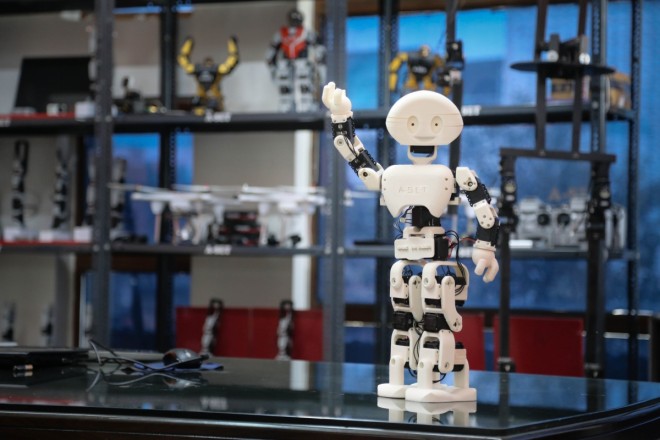Before we embark on our journey through the diverse realms of robots, let’s establish a clear understanding of what precisely constitutes a robot. In essence, a robot is a mechanical apparatus endowed with the ability to mimic specific human functions through electronic means, facilitated by computational systems. These machines are designed to execute tasks, whether intricate or straightforward, autonomously. Their operation draws from a spectrum of disciplines such as dynamic system modeling, mathematics, biology, physics, mechanical engineering, electrical and electronic engineering, computer science and engineering, as well as automation technology. The inherent versatility of robots, coupled with their capacity to undertake a wide spectrum of tasks and applications, positions them as indispensable assets in contemporary industrial landscapes.
Unveiling the Spectrum of Robot Types
Autonomous Vehicles: Navigating the Road to Innovation
Surpassing conventional expectations, robots have ventured into the realm of transportation through autonomous vehicles. These driverless marvels are categorized into six distinct levels of automation, as classified by the SAE. Each level signifies specific prerequisites that a vehicle must satisfy to operate at the designated level. Notable industry players, including nuTonomy, Zoox, Drive.ai, Tesla, Optimus Ride, and Waymo, are at the forefront of creating these revolutionary vehicles. Their endeavors are shaping the future of transportation, promising efficiency and safety in equal measure.
Collaborative Cobots: Bridging the Gap Between Humans and Machines
Collaborative robots, often referred to as cobots, redefine the boundaries between humans and machines. These intelligent entities function harmoniously in shared environments with human counterparts to fulfill their designated tasks. Noteworthy instances include the Sawyer cobot arm, aiding greenhouse workers in plant picking, and the Mitsubishi cobot, serving coffee at the Café X kiosk in Hong Kong. Cobots extend their utility beyond basic tasks, contributing to higher precision inspections and enhancing the accuracy of production processes.
Responding to Disasters: Robotic Heroes in Times of Crisis
Robots have proven their mettle in crisis management, undertaking perilous missions that involve rescue operations and critical activities during emergencies. The Hyrodnalix Emergency Integrated Lifesaving Lanyard (EMILY), a four-foot, 25-pound remote-controlled robot, serves as a hybrid flotation buoy-lifeboat, exemplifying its role in search and rescue efforts. Colossus from Shark Robotics emerges as a formidable aid in firefighting scenarios, effectively transporting equipment, evacuating victims, and employing its high-definition thermal camera to assess hazardous scenes. Notably, Colossus demonstrated its efficacy during the Notre-Dame Cathedral fire in France.
Aerial Prowess: Drones Redefining Industries
Unmanned Aerial Vehicles, commonly known as drones, have etched their presence across diverse industries as versatile tools for an array of tasks. From dissipating fog in China’s atmosphere to enabling aerial photography through products from Dji and Lehmann Aviation, drones have transformed the way industries function. They have even ventured into the realm of food delivery, with Domino’s DomiCopter serving as a pioneering example. The integration of drones has ushered in unprecedented efficiency and innovation.
Enchanting Entertainment: Robots Evoking Emotions
The world of robots extends beyond mere utility, embracing the realm of entertainment. Robots such as RoboThespian, Navi Shaman, and Partner are designed to evoke human emotions and provide entertainment experiences. An illustrative case involves the performance of four ABB robots on the stage of the National Centre for the Performing Arts in Beijing, captivating audiences with their remarkable talents.
Emulating Humanity: Humanoid Robots Redefine Possibilities
Humanoid robots blur the lines between man and machine, embodying human-like behaviors and activities. These robots replicate human movements, spanning activities from running and jumping to carrying objects. Notable examples include Surena IV from the Iranian University of Tehran, Sophia from Hanson Robotics, and Atlas from Boston Dynamics. Their ability to mimic human actions and expressions holds promise for applications across diverse domains.
Precision in Industry: Robotic Revolution on the Assembly Line
The industrial landscape witnesses a revolution driven by six distinctive types of industrial robots. These include articulated robots, Cartesian robots, SCARA robots, cylindrical robots, delta robots, and polar robots.
- Articulated Robots: Resembling human arms in structure, these robots exhibit a twisting joint connecting the arm to the base. The number of rotary joints within the arm varies, offering additional degrees of freedom.
- Cartesian Robots: Characterized by three linear joints aligned with the Cartesian coordinate system, these robots often include an attached wrist for rotational motion.
- SCARA Robots: Widely employed in assembly processes, SCARA robots are favored for their easy and unobstructed mounting.
- Cylindrical Robots: Designed for tasks such as assembly and spot welding, these robots feature rotary joints at the base and prismatic joints connecting the links.
- Delta Robots: Known as “spider robots,” these entities utilize base-mounted motors to control arms, positioning the wrist. Variations include 3-axis and 4- to 6-axis models.
- Polar Robots: Equipped with twisting and rotary joints, polar robots operate within a polar coordinate system, forming a spherical work envelope.
Robots Beyond Earth: Enabling Space Exploration
Robotic innovation extends beyond our planet, with specialized robots contributing to outer space missions. Noteworthy instances include Dextre, a robotic arm designed for equipment installation and replacement on the Space Station, and Robonaut 2, facilitating experiments. Spacebots have played pivotal roles in space exploration, including Dawn, the first spacecraft to orbit a dwarf planet, and Mars rovers Curiosity and Perseverance. These robotic entities continue to redefine the boundaries of exploration and discovery.







Leave a Reply